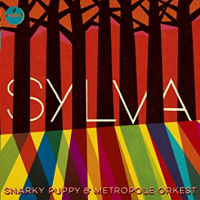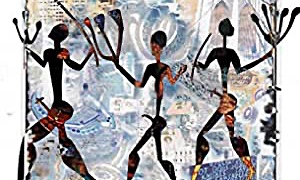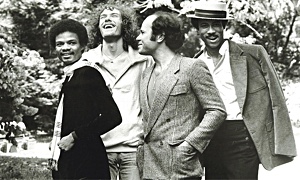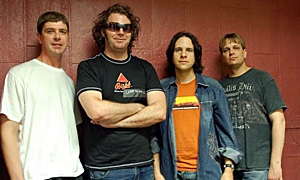Home » Jazz Articles » BackTracks » Live, Eclectic, And Electrifying
Live, Eclectic, And Electrifying
 Jan Hammer Group
Jan Hammer Group Live In New York
Country and Eastern Music
2008
Sometime in the '80s, jazz/rock keyboard master and Mahavishnu Orchestra alumnus Jan Hammer apparently got lured from his generic perch by the success he achieved scoring for TV, films and other media. This turned out to be a pretty serious detour because Hammer never really reacquired the musical impact he wielded in his mid-1970s fusion heyday. For proof of that impact, look no further than the 2008 archival release Jan Hammer Group Live In New York, a 1975 recording of his then freshly put-together group with drummer Tony Smith, bassist Fernando Saunders and violinist Steven Kindler.
Drawing on material from Hammer's The First Seven Days (Nemperor, 1975) and his joint foray with MO violinist Jerry Goodman Like Children (Nemperor, 1974), the quartet fires off an incendiary set that also features material to be included on what would be the apex of group's studio output, Oh Yeah? (1976, Nemperor). There are two other live documentations of this group, one being another archival release, Live In Dallas (Country and Eastern Music, 2014), the other being Jeff Beck's seminal With The Jan Hammer Group Live (Epic, 1977). While both certainly have their moments, the former album shows the group favoring the less exploratory, more vox/r&b-oriented material of its final days and the latter—even with Beck— just doesn't stack up against Live In New York's energy and freshness. For all of the ham-fisted, chops-fests that ended up giving fusion a bad name, this is one that shows how it was done at its cross-pollinating, adventurous (and live) best—and that it can still fire the mind while rattling the shutters.
 Jon Cleary and the Absolute Monster Gentlemen
Jon Cleary and the Absolute Monster Gentlemen Mo Hippa Live
FHQ Records
2008
If you're a musical aficionado of the melting pot called New Orleans —the city that birthed jazz along with so many other things— you probably already know of the anomaly named Jon Cleary. A British guitar-playing expatriate who loved NOLA music so much, he emigrated to the Crescent City in the '80s and got a job painting the storied Maple Leaf Inn so he could watch and learn from the certified practitioners of New Orleans piano. In the ensuing years, Cleary and his Absolute Monster Gentlemen have perhaps become the go-to torchbearers for that region's distinctively funky, piano-driven gumbo.
To catch Cleary and company in a live setting is to really appreciate their craft at its most electrifying but surely the next best thing to that is Mo Hippa Live. Their set on this album is the real deal, executed with the authority only hundreds of preceding road gigs can provide. Indeed it shows that if New Orleans was a Venn diagram for the places where jazz, blues, funk, R&B, gospel, soul, boogie woogie, (or anything with enough mojo to induce a shimmy) overlap, that is surely where this band resides. But difficult as it may be to accurately describe the NOLA musical amalgam, Cleary shows on Mo Hippa Live that it is possible to embody it—even if you're born on the other side of the pond. In the end, to understand, it's best to just do as the title track says: "Get out the way, and let the Gentlemen do their thing."
 Matt Garrison
Matt Garrison Shapeshifter Live 2010 Part 1
GarrisonJazz Productions
2010
If there's an album in the Garrison oeuvre that may benefit from hindsight, it's this one. While there is no denying the wonder of the unedited solo performance captured on Shapeshifter Live 2010 Part 1, at the time of its release its reception may have suffered from being the second live release from Garrison in only a few years—with versions of some material being issued for a second or third time. This may have been an understandable disappointment to those who thirsted for a full album of new material from the gifted composer and bassist, but these somewhat dashed expectations also may have gone a long way to obscure the extraordinary content contained herein.
Garrison, ever at the forefront of getting the most out of his talents and current technologies, revels in the aural capabilities of his bass and computer aided back-up in this live setting. But where others might use electronic assistance to merely "fill things out" in the absence of accompanying musical partners, Garrison also thoroughly plumbs the real-time interactive possibilities afforded by the tools at his disposal. This maintains a vital level of spontaneity throughout the proceedings. Despite this kind of "music at the technological edge" being notorious for not aging well, Garrison's efforts here were so well ahead of the curve, they still lie along the leading edge of the sonic and creative envelope over a decade later. It's easier now to see Shapeshifter Live 2010 Part 1 for what it was (and still is)—an exploratory feat of solo daring by an extraordinary musician, ever in the thick of innovation. It's an album definitely worth the visit/revisit and one that also begs the question: "Is there a part two?"
 The Outsidemen
The Outsidemen Band Overboard
Terra Nova Records
1996
By the time guitarist Mike Miller, bassist Jim Lacefield and drummer Ralph Humphrey were instructors at Musicians Institute in the mid 1990s, they already had serious recording and performing resumes. It is most fortunate then that when the three presented a performance / workshop to students (ostensibly on compositional development), someone pressed the record button. The resulting live set shows this gifted trio (dubbed The Outsidemen) tastefully burning through a fine mix of original compositions as well as a couple of choice covers (Jan Hammer's "Red And Orange'' and John McLaughlin's "Follow Your Heart''). As with so many live albums, the audio can be a bit dodgy at times but any shortcomings on that score are more than made up for by the content. The three give a lasting lesson in what a thinking-person's instrumental power trio really can be. This album would prove to be Lacefield's last recording before his untimely passing— eulogized by the final added studio cut "A Moment's Rest"— but also importantly, Band Overboard documents some of Humphrey's most enjoyable post-Zappa work along with being a beautifully unbridled showcase for the criminally under-recognized Miller.
 Snarky Puppy with the Metropole Orkest
Snarky Puppy with the Metropole Orkest Sylva
Impulse
2015
There are few if any recent bands flying around and about the jazz continuum with a trajectory like that of Snarky Puppy. If you've hitched onto that ride, chances are you've been witness to the band's evolution and movement through a few distinct periods. Their return to more traditional studio recording methods on their more recent albums notwithstanding, there was a multi-album stretch where the band recorded live in the studio in front of (or more accurately, amongst) an audience that seemed to capture a particular magic. Included in this period is the album that perhaps caused the most stir—the breakout We Like It Here (Ropeadope, 2014). But with the benefit of a few years added perspective, it may be their 2015 project with the Metropole Orkest Sylva that casts the more impressive and lasting shadow.
A few things account for this. On top of being the most sweeping project the band had ever attempted, Sylva was written in its entirety by leader / bassist Michael League at a time when he was seemingly at the peak of his compositional game. It was done in conjunction with the Metropole at a time when the Orkest was really hitting its stride with Jules Buckley's fresh vision as conductor. Its epic nature is as thematically cogent as it is encompassing of disparate musical styles. Add to it that Sylva is replete with shining contributions from individual SP members—some of whom were coming into their own enough to soon be moving on—and you have a convergence and synergy that's as unique to SP as it is to the Metropole. All this becomes even more palpable watching the accompanying DVD of the live performance. The beginning of the Pups' major roll had already started by the time Sylva was released and it was certainly obvious then that the album only added to their momentum, but its stature as a true landmark in their body of work keeps asserting itself with the passage of time.
Tracks and Personnel
Live In New YorkTracks: Darkness (Earth In Search Of A Sun); Red And Orange; Earth (Still Our Only Home); Topeka; Twenty-One; The Sixth Day/Country And Eastern Music; I Remember Me.
Personnel: Jan Hammer: keyboards and synthesizers; Tony Smith: drums, vocals; Fernando Saunders: bass, vocals; Steven Kindler: Violin.
Mo Hippa Live
Tracks: Go To The Mardi Gras; People Say; C'mon Second Line; Tipitina; Cheatin' On You; Port Street Blues; Help Me Somebody; Groove Me; When You Get Back; Mo Hippa.
Personnel: Jon Cleary: vocals, keyboards, cowbell; Cornell Williams: bass, vocals; Derwin "Big D" Perkins: guitar, vocals; Eddie Christmas: drums.
Shapeshifter Live 2010 Part 1
Tracks: Life Burning; Changing Paths; Exchange; Unity; Mirror Image; Family; Let Go; Izzy.
Personnel: Matt Garrison: bass, effects, computer.
Band Overboard
Tracks: Bad Dog; Sweet Fifteen; Rubber Legs; Who Knows; 5'll Getcha; Blockhead; Auto Worship; Red And Orange; Follow Your Heart; A Moment's Rest.
Personnel: Mike Miller: guitar; Jim Lacefield: bass; Ralph Humphrey: drums.
Sylva
Tracks: Sintra; Flight; Atchafalaya; The Curtain; Gretel; The Clearing.
Personnel: Snarky Puppy: Michael League: electric bass, Moog key bass; Bob Lanzetti: electric guitar; Mark Lettieri: electric guitar; Chris McQueen: electric guitar; Bill Laurance: piano, Wurlitzer, Moog; Cory Henry: organ, clavinet, Moog; Justin Stanton: Fender Rhodes, Moog, clavinet, piano, trumpet; Jay Jennings: trumpet, flugelhorn; Mike "Maz" Maher: trumpet, flugelhorn; Chris Bullock: tenor sax, clarinet, bass clarinet; Nate Werth: percussion; Robert "Sput" Searight: drums.
The Metropole Orkest: Jules Buckley: conductor; Arlia de Ruiter (concertmaster), Vera Laporeva, Denis Koenders, David Pejinenborgh, Pauline Terlouw, Casper Donker, Ruben Margarita, Tinka Regler, Seijia Teeuwen, Ewa Zbysznska: 1st violin; Merjin Rombout, Herman van Haaren, Wim Kok, Feyona van Iersel, Pauline Konig, Palina Cekov, Merel Jonker, Christina Knoll: 2nd violin; Mieke Honingh, Norman Jansen, Julia Jowett, Isabella Petersen, Iris Schut, Lex Lujinenburg: viola; Maarten Jansen, Emile Visser, Jascha Albracht, Annie Tongberg, Charles Watt: cello; Erik Winkelman, Arend Liefkes, Tjerk de Vos: double bass; Janine Abbos, Mariel van den Bos, Nola Exel: flute; Paul van der Feen, Leo van Oostrom, Leo Janssen, Werner Janssen, Max Boeree: clarinet, bass clarinet, contrabass clarinet, saxophone; Pieter Hunfeld, Rob van de Loor, Fons Verspaandork, Elizabeth Hunfeld: horn; Jan Oosting, Vincent Veneman, Jon Bastiani: trombone; Martin van den Berg: bass trombone; Ries Schellekens: tuba; Mark Jiskoot, Frank Warndenier: percussion.
BackTracks is a series that looks back at notable albums that were somehow absent from All About Jazz's extensive 50,000 plus review archive (or are just plain worthy of another look).
< Previous
Duke Ellington meets Bordeaux
Next >
Billy Bob Thornton
Comments
Tags
Backtracks
Mike Jacobs
Country and Eastern Music
Mahavishnu Orchestra
Jan Hammer
Tony Smith
Fernando Saunders
Steven Kindler
Jerry Goodman
jeff beck
FHQ Records
Jon Cleary
Matt Garrison
GarrisonJazz Productions
Terra Nova Records
Mike Miller
Jim Lacefield
Ralph Humphrey
John McLaughlin
Impulse
Snarky Puppy
Metropole Orkest
Michael League
Jules Buckley
For the Love of Jazz
 All About Jazz has been a pillar of jazz since 1995, championing it as an art form and, more importantly, supporting the musicians who create it. Our enduring commitment has made "AAJ" one of the most culturally important websites of its kind, read by hundreds of thousands of fans, musicians and industry figures every month.
All About Jazz has been a pillar of jazz since 1995, championing it as an art form and, more importantly, supporting the musicians who create it. Our enduring commitment has made "AAJ" one of the most culturally important websites of its kind, read by hundreds of thousands of fans, musicians and industry figures every month.























